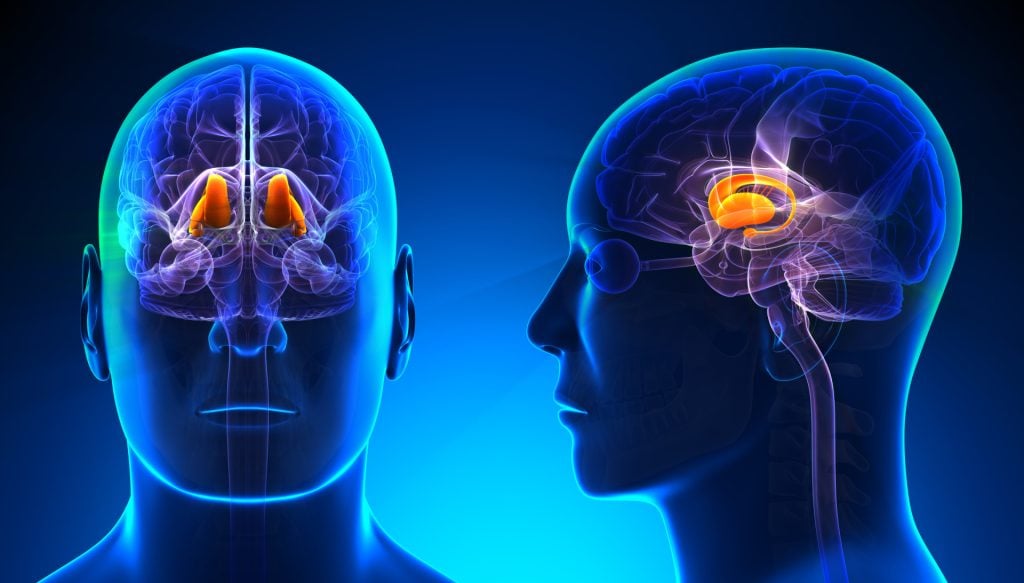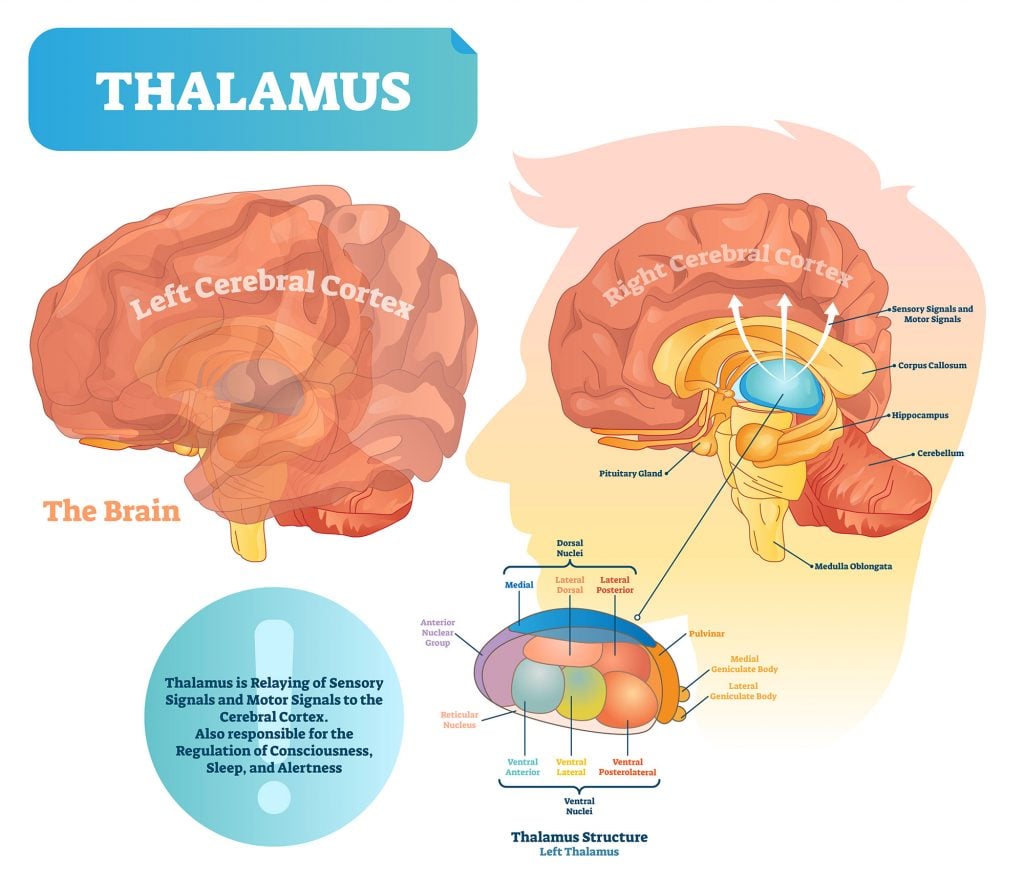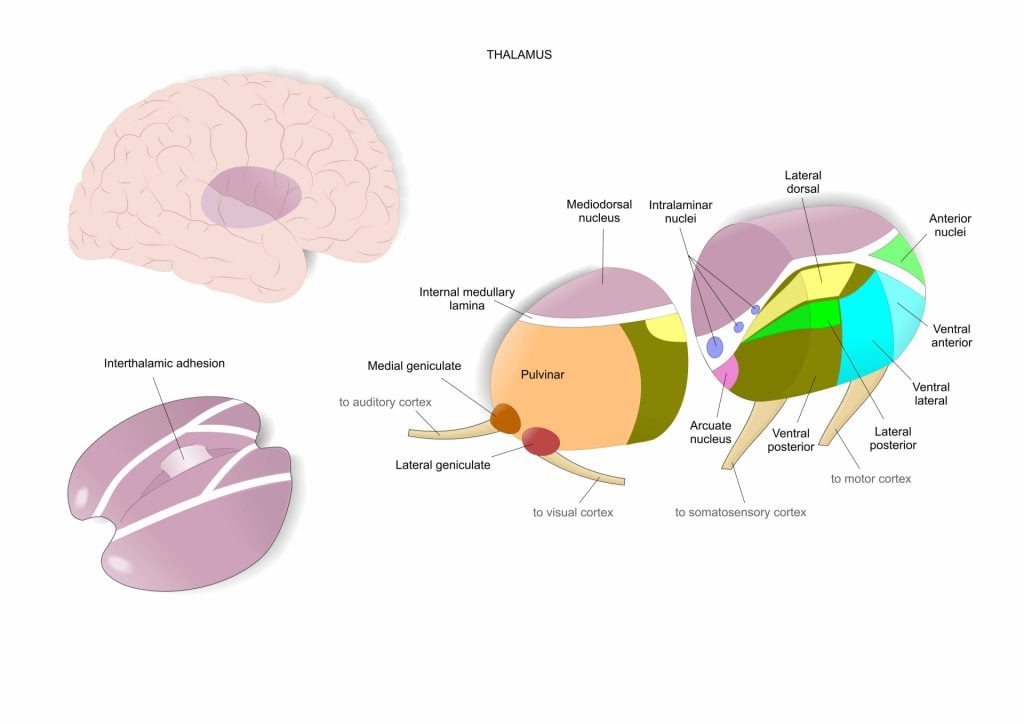On This Page:
The thalamus is a paired structure in the brain, acting as a relay center. It processes and transmits sensory and motor signals to the cerebral cortex and regulates consciousness, sleep, and alertness.
The thalamus is situated at the core of the diencephalon, which is a part of the forebrain, and contains the hypothalamus, epithalamus, and subthalamus.
The thalamus is often described as the brain’s relay station as a great deal of information that reaches the cerebral cortex first stops in the thalamus before being sent to its destination.

All of our senses, except smell, are outed through the thalamus before being directed to other areas of the brain for processing.
There are two thalami, one in each hemisphere of the brain. They lie above the brain stem and the midbrain (or mesencephalon), which allows for connections of nerve fibers to reach the cerebral cortex in all directions.
This structure of the brain can relay and integrate a variety of motor and sensory signals between the higher centers of the brain and the peripheries.
The thalamus is mostly comprised of grey matter but is surrounded by two white matter layers. They are oval-shaped in appearance, almost looking like eggs, with two protuberances on the surface.
One of these is known as the medial geniculate bodies, which are important for auditory information processing. The other is the lateral geniculate bodies, which are responsible for the processing of visual sensory inputs.
The thalamus comprises different types of nuclei, each of which serves a unique purpose, from relaying sensory and motor signals to regulating consciousness and alertness.
Function
In psychology, the thalamus is recognized as a primary relay station in the brain. It directs sensory and motor signals to the cerebral cortex, excluding olfactory information.
Additionally, the thalamus plays a pivotal role in consciousness, sleep, and alertness, influencing our awareness and attention. It acts as a gatekeeper, filtering sensory data before it reaches higher cognitive brain regions.
As the thalamus is heavily involved in relaying information between the cortex and the brain stem, as well as within different cortical structures, it contributes to many brain processes.
Historically believed only to be related to sensory relay in visual, auditory, somatosensory, and gustatory systems, it has since been found to be involved in many other functions beyond these.
Below is a list of some of the associated functions:
- Contributions to perception
- Relaying motor information
- Relaying sensory information
- Role in memory
- Alertness and attention
- Consciousness and awareness
- Role in cognition
Connections to structures such as the hippocampus and other parts of the limbic system suggest the thalamus plays a role in memory, especially episodic memory, as well as with learning and emotions.
The thalamus is also believed to be involved in the regulation of sleep, wakefulness, and arousal. The thalamus filters through information between the brain and the body.
Every sensory function, except for olfaction (sense of smell), has a thalamic nucleus that receives, processes, and transmits information to associated areas within the cerebral cortex.
Generally, the connections between the sensory organs of the body and the thalamus are contralateral, meaning they communicate with the opposite side of the body.
Whereas the connections between the thalamus and the cerebral cortex are ipsilateral, meaning they communicate on the same side of the brain.
Nuclei within the thalamus
The thalamus is made up of a series of nuclei, all of which are responsible for the relay of different sensory signals.
The nuclei are both excitatory and inhibitory in nature and receive sensory or motor information from the body, presenting selected information via the nerve fibers to the cerebral cortex.


Described below are a list of some of the main groups of nuclei within the thalamus and what they are responsible for:
Anterior nucleus
The anterior nucleus is thought to be involved with memory due to its extensive connectivity to the hippocampus.
It is also connected to the mammillothalamic tract (from the mammillary nucleus of the mammillary bodies to the hypothalamus) and the cingulate gyrus (involved in processing emotions and behavior regulation).
As these areas are linked with the limbic system, they are involved in organizing memory and emotion. The anterior nucleus essentially receives input from the limbic system and projects to the cingulate gyrus.
Dorsomedial nucleus
The dorsomedial nucleus is thought to be involved in emotional behavior and memory.
This nucleus relays information from the amygdala and olfactory cortex, which then projects to the prefrontal cortex and the limbic system, in turn relaying them to the prefrontal association cortex.
Because of this, the dorsomedial nucleus has an important role in attention, organization, planning, and higher cognitive thinking.
Ventral posterolateral and ventral posteromedial nucleus
These both act as relay nuclei sending somatosensory information to the somatosensory cortex, a region that receives and processes sensory information about the body.
Further, the ventral posteromedial nucleus receives sensory information from the trigeminal nerve regarding the face.
Ventral anterior and ventrolateral nucleus
These two nuclei are the motor relay nuclei, which receive inputs from the cerebellum and the basal ganglia.
They are thought to be involved in motor functions, and both have pathways leading to the substantia nigra, premotor cortex, reticular formation, and the corpus striatum.
Lateral posterior nucleus
The lateral posterior nucleus is believed to be involved in integrating sensory input and associating it with cognitive functions. Its other functions include being able to determine visual stimuli which stand out the most and visually guided behaviors.
Pulvinar nucleus nucleus
The pulvinar nucleus is thought to be involved in the processing of visual stimuli and with having strong connectivity to the visual cortex.
The pulvinar nucleus projects to the amygdala and the striatum (an area involved in decision-making, reinforcement, and motivation).
This is thought to aid in relaying visual information to guide precise movements as well as relaying visual information to the amygdala.
Medial geniculate and lateral geniculate nucleus
These nuclei are important for relaying auditory and visual information, respectively. The lateral geniculate nucleus receives visual information from the retinas of the eyes, which projects to the visual cortex of the occipital lobe.
The medial geniculate nucleus receives auditory information from the inferior colliculus (a part of the midbrain that is the main auditory center) and projects this to the primary auditory cortex within the temporal lobe.
Reticular nucleus
The reticular nucleus forms a sheet that makes the outer covering of the thalamus and can influence the activity of other nuclei within the thalamus.
The reticular nucleus receives input from the cerebral cortex as well as the dorsal thalamic nuclei.
This is the only nucleus of the thalamus that does not project out to the cerebral cortex but instead modulates the information from other nuclei in the thalamus.
Disorders
Since the thalamus acts as a relay station from which it sends input and receives output from many brain structures, damage to this area can impact many brain functions.
Below is a list of symptoms that may be associated with damage to the thalamus:
- Amnesia
- Aphasia
- Difficulties with attention
- Impaired movement
- Impaired posture
- Chronic pain
- Sleepiness
- Loss of alertness and activation
- Impaired processing of sensory information
- Apathy
As the thalamus plays a key role in sleep-wake regulation, damage to this area has been implicated in consciousness-related disorders, as well as resulting in individuals being in a coma.
Due to the thalamus being important for generating normal sleep thalamocortical rhythms, sleep disorders may result from damage such as insomnia.
Language deficits because of thalamic damage, known as thalamic aphasia, can result in difficulties with lexical semantics. Similarly, this can cause verbal paraphasia, which is a speech disturbance, presenting as jumbled up words or meaningless speech.
Disorders of the thalamus can also manifest itself in the form of sensory loss, movement disorders, pain syndromes, and visual disorders. A stroke is a common cause for many disorders of the thalamus.
Thalamic pain syndrome can occur when there are disturbances in one of the pathways of the thalamus which affects the sensation of temperature following a stroke. This can result in tingling or burning pain, as well as discomfort with temperature changes.
Months after having a thalamic stroke, this can eventually lead to severe chronic pain. Stokes of the thalamus have also been found to produce symptoms of uncoordinated involuntary movements of the body due to affecting the pathways associated with motor movements.
It has been found that patients with schizophrenia had significantly less thalamic volume in comparison to those without schizophrenia (Coscia et al., 2009).
The reduced thalamic size was suggested to be correlated with worse neuropsychological functioning and specific deficits in language, motor, and executive skills.
This implies that the differences in thalamic structure are significantly related to some of the symptoms of schizophrenia.
Another study was conducted to investigate the thalamic differences in those with Autism.
It was discovered that autistic males had lower and weaker increases in functional connectivity with their thalamus (Tomasi & Volkow, 2019).
It has also been found that there was non-typical thalamic connectivity in the temporal and motor areas of those with autism (Woodward et al., 2017).
References
Coscia, D. M., Narr, K. L., Robinson, D. G., Hamilton, L. S., Sevy, S., Burdick, K. E., Gunduz-Bruce, H., McCormack, J., Bilder, R. M. & Szeszko, P. R. (2009). Volumetric and shape analysis of the thalamus in first‐episode schizophrenia. Human brain mapping, 30 (4), 1236-1245.
Mandal, A. (2021, February 15). What is the Thalamus? News Medical Life Sciences. https://www.news-medical.net/health/What-is-the Thalamus.aspx#:~:text=The%20thalamus%20is%20a%20small,signals%20to%20the%20cerebral%20cortex
Tomasi, D., & Volkow, N. D. (2019). Reduced local and increased long-range functional connectivity of the thalamus in autism spectrum disorder. Cerebral Cortex, 29 (2), 573-585.
Torrico, T. J., & Munakomi, S. (2019). Neuroanatomy, Thalamus.
Woodward, N. D., Giraldo-Chica, M., Rogers, B., & Cascio, C. J. (2017). Thalamocortical dysconnectivity in autism spectrum disorder: an analysis of the autism brain imaging data exchange. Biological Psychiatry: Cognitive Neuroscience and Neuroimaging, 2 (1), 76-84.

